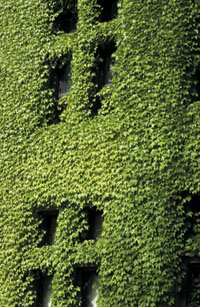 |
|
|
…the shock of the new. If you haven’t spent much time in the southeastern United States, you may not know what kudzu is. On the other hand, if you own property south of the Mason-Dixon Line, you may know all too well the staying power of the vine, originally imported from Japan as landscaping for that country’s pavilion at the 1876 Philadelphia Centennial Exhibition. Around the turn of the 20th century kudzu gained kudos as a good forage plant for cattle and pigs, especially in times of drought, and as a way to slow soil erosion.
In the South its use spread like a weed. Or like kudzu. Climbing up and over trees and buildings almost in the blink of an eye, the creeping plant has long since become entwined in Southern culture: “You know you’re a redneck,” the joke goes, “if you’ve ever lost a relative to kudzu.” Although I haven’t lost a relative to kudzu (yet), I’ve seen enough Pueraria lobata to note the family resemblance to its academic cousin, Parthenocissus tricuspidata. But while ivy is considered a precious heirloom, a symbol of time-honored tradition, kudzu is an upstart, willy-nilly taking over all in its path. Tradition and change are perennial topics on any college campus. In part it’s because traditions form so quickly in a population where a generation spans approximately four years. “We’ve always done it that way,” says the June graduate, unaware that “always” dates only to the spring before she matriculated. And in part it reflects the age-old tension between received wisdom and the shock of the new. In the academy’s marketplace of ideas, both compete as cash crops. This spring, as the ivy regained its foothold on the Gothic limestone, a slightly younger tradition felt the pruning shears. The College Council voted to change the term used to denote an undergraduate’s field of specialization from concentration to major (see “College Report,”). The reasons are practical (doing away with confusion both on campus and off), but the result is that the naysayers (at Chicago naysayers generally abound) find themselves in the common if incongruous position of advocating a tradition whose own roots lie in a break with tradition. In this case, concentration was a 1950s semantic sleight of hand designed to calm proponents of the Robert Maynard Hutchins school of general education, to whom major and undergraduate specialization were, as they say in kudzu country, fightin’ words. Having laboriously learned the particular peculiarity of using concentration when we meant major—in much the same way that an American in Britain goes native, ostentatiously adding milk to one’s tea and skipping over the w in Keswick—the Magazine will now reverse direction and obey the College Council’s edict. But if we occasionally relapse, give us a break. Remember, it takes a while to cultivate a tradition.—M.R.Y.
|
|
phone: 773/702-2163 | fax: 773/702-8836 | uchicago-magazine@uchicago.edu


